Regulatory Intelligence: Faster MoPH Approval in Qatar
Use Regulatory Intelligence to align ingredients, claims, testing, and Arabic labels with MoPH rules—avoid queries, cut rework, and launch faster in Qatar.
BLOGS
11/15/20253 min read


Regulatory Intelligence
for Faster MoPH Approval in Qatar
Expanding into Qatar is attractive, but approvals stall when teams guess the rules.
Regulatory intelligence removes guesswork by aligning product decisions with MoPH expectations before labels are designed, ingredients are fixed, or tests are booked.
Treated as an ongoing practice—not a last‑minute search—it shortens time to approval and protects budgets.
What Regulatory Intelligence Means in Qatar
Regulatory intelligence is the discipline of collecting, analysing, and applying local requirements so every decision supports a clean submission.
In Qatar this covers how a product is classified under MoPH, which ingredients and claims are acceptable, what the Arabic label must include, which tests are expected for the category, how documents must be legalized and translated, and what has recently changed in the portal or forms.
When these threads are considered together, you plan once instead of reworking the file at each step.
The Cost of Late Planning
Most delays are not caused by the authority’s timeline but by preventable rework.
A formula is finalised only to discover an ingredient limit that forces reformulation. Artwork is printed and then returns for Arabic corrections or claim adjustments.
A test report arrives but doesn’t reflect the exact Qatar formulation, so it cannot be used. Each correction consumes weeks and pushes launch windows. Early intelligence replaces these loops with a single, coherent path.
Five Decisions to Lock Before Artwork
Category and pathway: cosmetic, disinfectant, supplement, or food each carry different evidence and claims boundaries. Choosing correctly sets the entire dossier structure.
Ingredient map: confirm allowability, limits, and interactions for the exact formulation intended for Qatar, not a regional variant.
Claims boundary: decide what can be said in Arabic and English with supporting evidence, and remove therapeutic language that will trigger queries.
Testing plan: select the right studies and accredited providers, and schedule them to match the final formulation and real lead times.
Legalization and translation sequence: lock the order of attestation and certified translation so documents are current at submission and consistent across the pack.
A Practical Timeline That Prevents Rework
Begin with a horizon scan several months before intended submission to confirm category, ingredient status, claims and likely testing.
As the product moves from concept to production, start collecting documents, arrange certified Arabic translation, and launch the legalization pipeline
Finalise artwork only after the translation proof is approved and key analytical results are in hand.
Immediately before filing, run a consistency review—figures and claims must match across formula, reports and labels—then submit with roles assigned to answer portal queries quickly.
After approval, keep monitoring for changes that affect ingredients, statements or mandatory label items.
Qatar‑Specific Pitfalls We See—and How They Are Prevented
Misaligned Arabic and English content is a common trigger for queries; a bilingual proofing step prevents it.
Legalized certificates that expire between booking and submission derail files; tracking validity dates avoids last‑minute replacements.
Reports that describe a regional formulation are rejected; testing must reflect the Qatar product.
Claims that imply therapeutic benefit without evidence attract scrutiny; setting claim language early keeps labels inside acceptable boundaries.
How We Work With Your Team
Engagement begins with a structured intake of SKUs, intended claims and launch priorities.
We run a risk scan to surface classification traps, ingredient flags and evidence gaps, then convert that output into a document map and testing plan aligned to the chosen pathway.
Labels are built against a clear Arabic checklist so mandatory items, date formats and origin statements are correct the first time.
Before submission, a single reviewer reconciles figures across formula, artwork and reports to remove inconsistencies.
During review we manage portal communications so clarifications are answered quickly and the file keeps moving.
Who Benefits Most
Importers and brand owners introducing foods, cosmetics, supplements or household products to Qatar gain the most from early intelligence, especially when adapting a GCC or EU pack for local expectations.
Teams with fixed launch windows also benefit because the work replaces uncertainty with a predictable sequence.
Final Thought
Regulatory intelligence is not extra process—it is the method for avoiding rework.
By locking decisions in the right order and grounding them in MoPH expectations, you submit once, answer fewer queries and reach the shelf sooner.
🔗 Related Services
Fix issues before they arise with Crisis Management & Advocacy
Start your process with clarity using our Free Consultation
Protect your sustainability claims with Environmental Compliance
Avoid the most common mistake in product registration by understanding Qatar’s classification rules first.
Ready to Ensure Your Product is Fully Compliant?
Fill out the form below and let our experts guide you through label checks, formula validation, and registration—step by step.


